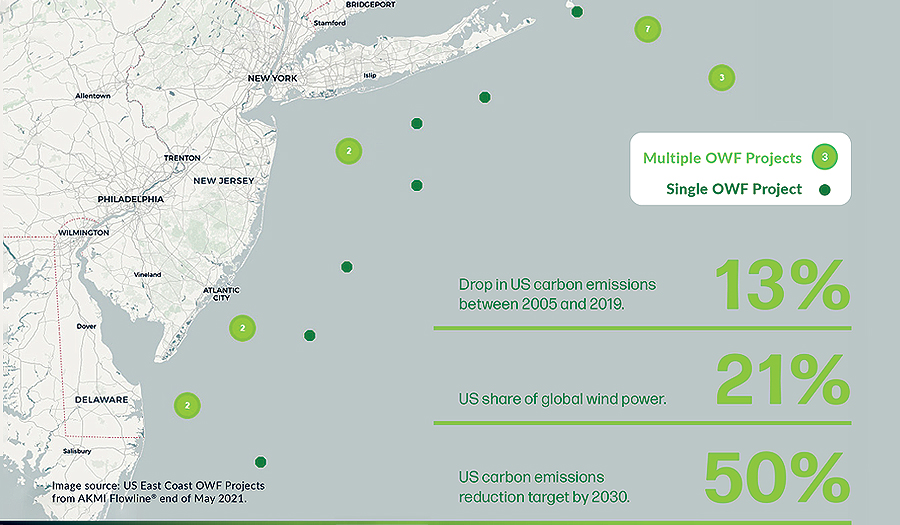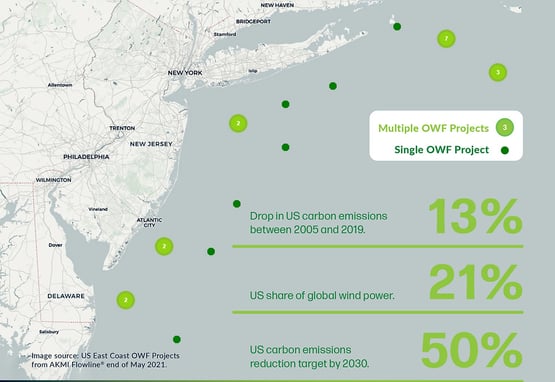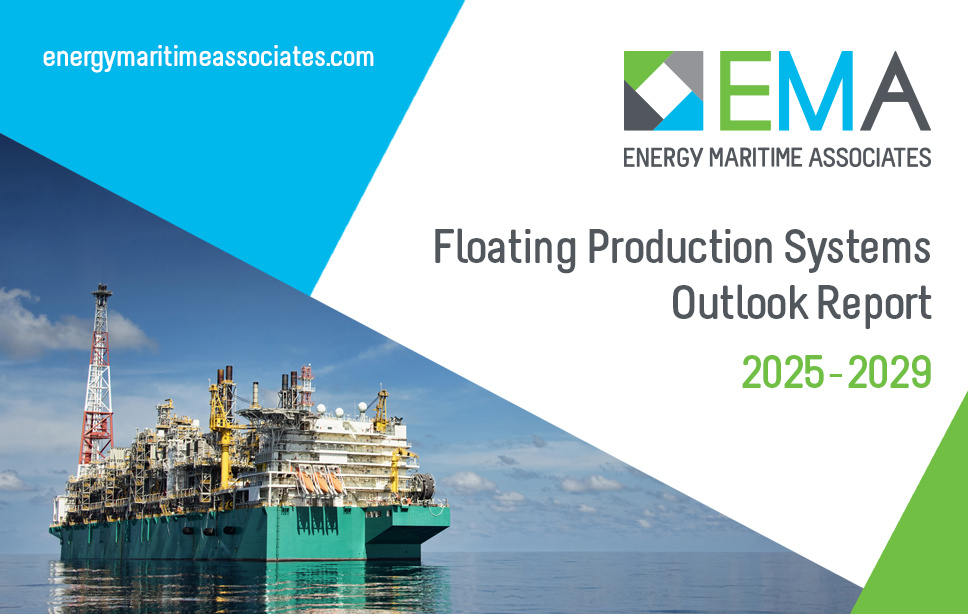3 min read
Do Biden’s net-zero plans mean it’s time for lift off for US offshore wind?
![]() Archer Knight
:
June 16, 2021
Archer Knight
:
June 16, 2021

Scott Mitchell, Archer Knight’s director of strategic growth, on what's next for the sector
Roadmap to US carbon neutrality
President Biden’s administration has bold plans to make the US carbon neutral by 2050. The roadmap includes a 50% cut in carbon emissions by 2030 (compared with 2005’s record levels).
In 2019, US carbon emissions were 13% lower than 2005. 29% of US greenhouse gas emissions come from transportation, with electricity generation and industrial activity being the next largest polluting sectors.1
Strategies central to achieving these goals include updating the power grid to make it more efficient, a shift to electric vehicles, and reducing consumption of fossil fuels.
To achieve this, means enhancing and accelerating investment in renewables. Consequently, the development of the US offshore wind power sector will play a critical role in meeting the 2050 goals.
Putting US wind power in context
The US has seen a dramatic rise in wind power over the past 20 years. In 2000, the US generated a modest 6 billion kWh from wind farms.
Last year, the output had risen to 338 billion kWh. The sector represents 8.4% of total US electricity generation.2
A total of 42 US states now have utility-scale operational wind farms. Meanwhile five of these states; Texas, Iowa, Oklahoma, Kansas, and Illinois, accounted for 58% of US wind power generation in 2020.3
The US is the world’s second-largest wind power generator, providing 21% of global wind electricity (China is the world’s largest producer, with 29% of global supply).

| Archer Knight’s Flowline platform is part of the AMi subscription package and contains thousands of data points on offshore wind and energy projects. Click here to find out more. |
The prospects for offshore wind generation
Almost all US wind electricity is generated from onshore wind. The majority of these wind farms are located in the US Central Plains. Here, the environmental and commercial conditions are conducive to the economically viable development of large-scale wind projects.
Currently, the US only has one commercial offshore wind electricity project. The Block Island Wind Farm lies off the Coast of Rhode Island. This project has an operating capacity of 30MW.
Could this be about to change? President Biden has announced a target of increasing the East Coast’s offshore wind power generation capacity to 30GW by 2030. This goal is hugely ambitious, given the practicalities of planning and executing the installation of the numerous offshore wind projects it requires.
We are unlikely to see this come to fruition without federal assistance – in the form of accelerated approval processes and supported by financial subsidies and grants. Is there financial support available? Up until now, the Production Tax Credit (PTC), a federal tax credit, has been applied to every kWh produced over a wind farm’s first decade in operation.
Is there financial support available?
The PTC has been successful in incentivising new wind farm developments. The industry has been issued US$25bn in PTC since 2010. However, the PTC is now being phased out for new wind farms. Without it, new developments will become less competitive.
To help encourage renewable energy projects, many states have enacted Renewable Portfolio Standards. These require that a certain amount of each state’s electricity is generated from renewable sources. Consequently, there’s strong support for most renewable projects at both the state and federal level in the US.
So Can offshore wind be competitive?
Offshore wind energy is currently the most expensive alternative to conventional power generation. A new offshore wind farm project is estimated to cost three times as much as a comparable combined cycle natural gas plant. Over time, the cost of US offshore wind power generation is likely to fall and become more competitive. However, the economics of offshore US wind power generation is still seen as prohibitive to many investors.
These projects face other challenges too. These include the potential negative impact developments may have on the marine ecology and fish populations. Local communities might also object to wind farms being developed in their ‘back yards’.
The chances of success for Biden and US offshore wind power
If the US East Coast can, as hoped, generate 30GW from offshore wind farms by 2030, this will be enough to power 10 million homes. To enable growth in the offshore sector, President Biden’s administration is likely to support the fast-tracking of offshore wind developments located in the waters off the US East Coast.
However, his plans are likely to meet resistance from environmental groups and community stakeholders. Wind farm developers will also look for financial incentives before committing their capital. In other words, significant issues will need to be addressed before the President’s offshore wind energy plan for 2030 can be realised. What does this mean for your business? Companies in the energy supply chain and services sector may want to consider the US wind electricity generation sector for its future growth potential. As US energy policy shifts towards proven renewable technologies, such as offshore wind, investment opportunities in the sector will become more numerous.
This article originally appeared in Energy Evolution, the new publication available to subscribers to Archer Knight’s AMi service. Find out more about the benefits of subscribing, including access to Flowline, our SaaS platform, market assessment reports and on-demand research requests here.
Scott Mitchell is Archer Knight’s Director of Strategic Growth based in the US.
See how your business can make more sense of the US renewables market. Contact Scott at smm@archerknight.com
Sources:
-
Inventory of US Greenhouse Gas Emissions and Sinks US Environmental Protection Agency.
-
Power Technology – Top 10 US states by wind energy capacity, 15 April 2019.

2 min read
Experts give their views on future of floating energy
Inaugural event helps industry leaders understand the challenges ahead Technological innovation. Learning from experience. Collaboration....

4 min read
What does ‘destination net zero’ mean for oil & gas?
COVID-19 has brought green energy further up the agenda Our energy use has changed dramatically in the last few months, the result of a global...

2 min read
Speakers announced for inaugural Floating Energy Forum
It’s an exciting time for the offshore sector. Floating energy is a growing and competitive area of interest from right across industry. Archer...



